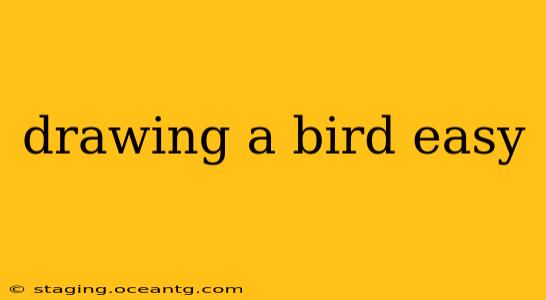Birds, with their diverse shapes and vibrant colors, make captivating subjects for drawing. Whether you're an experienced artist or just starting out, learning to draw a bird can be a rewarding experience. This guide provides easy-to-follow steps for drawing a simplified bird, perfect for beginners. We'll cover basic shapes, proportions, and techniques to help you create your own feathered friend.
What are the basic shapes of a bird?
Understanding the basic shapes that make up a bird's body simplifies the drawing process considerably. Think of the body as a slightly elongated oval or teardrop shape. The head is a smaller circle or oval attached to the body. The beak is a triangle or a slender cone. Wings can be simplified as slightly curved teardrops or elongated ovals. The tail is often a triangle or fan shape. By breaking down the bird into these fundamental forms, you establish a solid foundation for your drawing.
How do I draw a simple bird step by step?
Let's draw a simple bird together! Follow these easy steps:
-
Start with the body: Lightly sketch an oval shape. This will be the main body of your bird.
-
Add the head: Attach a smaller circle or oval to one end of the larger oval. This forms the head.
-
Draw the beak: Add a small triangle or slender cone to the bottom of the head. Experiment with different beak shapes; some birds have longer, thinner beaks, while others have shorter, more robust ones.
-
Sketch the wings: Lightly draw two slightly curved teardrops or elongated ovals extending from the sides of the body. These are your wings. Adjust their size and shape to fit your bird's style.
-
Add the tail: Draw a triangle or a fan-shaped tail at the opposite end of the body from the head.
-
Refine the details: Once you're happy with the basic shapes, start refining the details. Add a small curve to the underside of the body to indicate the belly. You can also add simple lines to suggest feathers. Don't worry about perfect detail at this stage.
-
Erase guidelines: Gently erase the initial guidelines, leaving the refined bird drawing.
-
Add finishing touches: Consider adding an eye (a small circle or dot), feet (simple lines or triangles), and subtle shading to give your bird more character and depth.
What are some tips for drawing birds?
-
Use light pencil strokes: This allows you to easily erase and adjust your drawing as needed.
-
Observe real birds: Pay attention to their proportions, shapes, and postures. Photographs are also useful references.
-
Start with simple shapes: Don't get bogged down in details. Begin with basic shapes and gradually add complexity.
-
Practice regularly: The more you practice, the better you'll become at drawing birds.
What are good materials for drawing birds?
You don't need expensive materials to draw a bird. A basic set of pencils (HB, 2B, 4B) and an eraser are sufficient to get started. A sketchbook or drawing pad provides a good surface for practicing.
How can I improve my bird drawings?
The key to improving your bird drawings is practice and observation. Study the anatomy of birds; understanding their skeletal structure and musculature can significantly improve your drawings' accuracy. Experiment with different techniques, such as hatching and cross-hatching, to create texture and depth in your drawings. Don't be afraid to try drawing different types of birds to expand your skills and explore diverse shapes and features. Consistent practice and a curious eye will help you steadily improve your bird drawings.
What are some common mistakes to avoid when drawing birds?
One common mistake is neglecting proportions. Ensure the head, body, wings, and tail are appropriately sized in relation to each other. Another is over-detailing before establishing the basic shapes. Start with simple forms, and gradually add details as you refine your drawing. Finally, many beginners struggle with creating dynamic poses. Study birds in motion and try to capture their energy and movement in your drawings.
By following these steps and tips, you’ll be well on your way to creating beautiful and engaging bird drawings. Remember, practice makes perfect, so don't be discouraged if your first attempts aren't exactly as you envisioned. Keep practicing, and you will see improvement over time.
